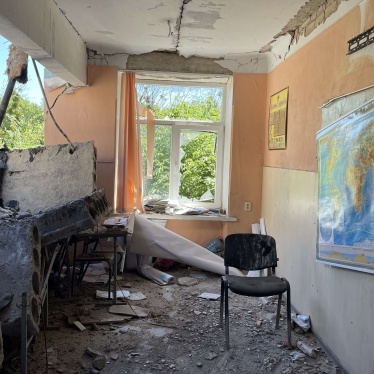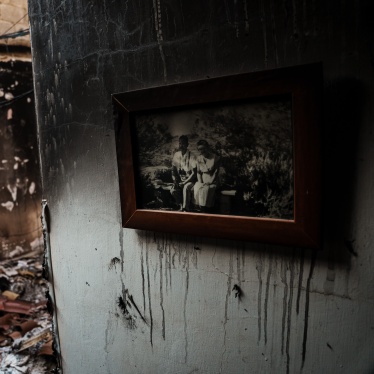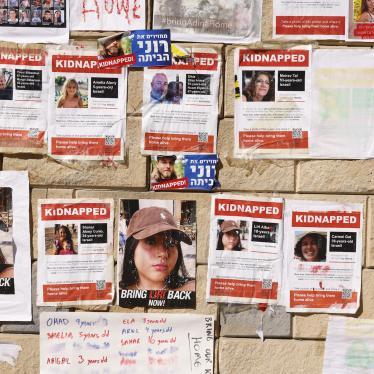We write in advance of the 87th pre-session of the Committee on the Rights of the Child relating to Ukraine’s compliance with the Convention on the Rights of the Child. This submission focuses on the protection of education during armed conflict.
Protection of Education During Armed Conflict (Article 28)
Since the beginning of the armed conflict in Ukraine, Human Rights Watch has extensively documented human rights violations and abuses, as well as violations of international humanitarian law, by all parties to the conflict in eastern Ukraine. Hostilities have subsided since 2016, but the conflict has not ended and many concerns remain.
Numerous schools in conflict-affected areas made commendable efforts to minimize disruptions to children’s education by switching to either distance learning or a hybrid of classroom and distance learning during intense periods of fighting. Distance education generally involved teachers providing assignments and collecting homework at the school or at student’s homes, and then using methods such as telephone, email, and Skype to reach students to answer questions. Yet students and educators alike acknowledged that the quality of education children receive through distance learning was inferior to the quality of education received through classroom learning.
Human Rights Watch documented attacks on schools and military use of schools in Ukraine in 2016 and found that both sides of the conflict have carried out indiscriminate or deliberate attacks on schools and used schools for military purposes.[1] Human Rights Watch recognizes that the government is not responsible for attacks on schools and military use of schools by Russia-backed separatists and that schools in separatist-controlled regions are not under its control. Below, we summarize our findings on infringements on the right to education in government-controlled areas, where the government has the power to make improvements.
Human Rights Watch found that the destruction of vital educational infrastructure has affected access to education, with many children facing interruptions to their schooling due to evacuations and unsafe conditions. This destruction has also affected the quality of education, for example by causing overcrowding in classrooms as damaged schools await repairs. According to the United Nations Office for the Coordination of Humanitarian Affairs (OCHA), the temporary closing of schools in government-controlled areas in the first half of 2018 alone has affected the education of over 6,000 children.[2]
Human Rights Watch documented 15 attacks on schools that were not being occupied or used by the military and therefore did not appear to constitute military objectives. Some of these attacks were carried out by government forces. A Ukrainian soldier told Human Rights Watch that a fire that destroyed a school building in Stanytsia Luhanska, a government-controlled area approximately 25 kilometers from Luhansk, was started by an airstrike carried out by Ukrainian government forces in August 2014.[3] When Human Rights Watch visited the school in November 2015, it was still in ruins.
Military use of schools not only infringes upon the right to education but also places students at risk. Ukrainian government forces have deployed in and near schools and used schools for various military purposes, including to deploy fighters, store weaponry, and use them directly as bases of operation due to their strategic locations. In a November 2015 meeting with the Ministry of Education and Science, officials told Human Rights Watch that they were aware that Ukrainian government forces have used schools for military purposes but said they did not collect data on it.[4]
During a Human Rights Watch mission to Novosvitlivka village, local residents said that in August 2014 Ukrainian military forces used the village’s school as a base. When Human Rights Watch visited the school in September 2015, a school guard said that the school was destroyed by Grad rocket attacks during Ukrainian soldiers use of the school. More than one year after the attacks, the school building was still largely destroyed. The guard said that the number of children attending the school was reduced by half and that the remaining children were attending a smaller school at the other end of the village, which was getting overcrowded as more children returned.[5]
At Kindergarten Number 3 in Ilovaisk, under the control of Russia-backed armed groups, the director told Human Rights Watch that the Ukrainian military started using the kindergarten on August 7, 2014 and occupied it for 23 days: “When the soldiers came, we opened the doors and showed them that there was no enemy inside and that we were not hiding anyone. But still the armed men walked in and stayed. They broke all the doors, sinks, practically all the dishes. Furniture, kids’ beds – everything was either stolen or broken.” The principal said that while the kindergarten was being used by Ukrainian government forces, it sustained several direct hits, severely damaged the building.[6]
On August 18, 2014, government forces entered School Number 14 in Ilovaisk and set up a headquarters. The school principal told Human Rights Watch that soldiers remained there for three weeks. During their stay, the principal said, the soldiers damaged furniture, broke doors, and smashed computers. Researchers found several unexploded landmines on the school grounds, apparently ejected from a supply truck they were stored on when the truck was attacked while parked in the schoolyard.[7]
A staff member of the Yenakiieve Specialized School Number 1 for Orphans with Impaired Vision, in Yenakiieve, told Human Rights Watch that government forces deployed in the school in August 2014 and remained there for six months. All the children were evacuated. The school was severely damaged during fighting in February 2015 and was not operational when Human Rights Watch visited in September 2015.[8]
Russia-backed armed groups broke down the front door to School Number 4 in Krasnohorivka during the summer holidays in July 2014, and deployed inside the school for approximately one week. After they left, Ukrainian army soldiers entered the school one Saturday in either late August or early September, and remained there for more than one year, until September 29, 2015. They told the teachers who tried to return to school that they could not enter their school because it was now a military site, made them stand on the roadside, and delivered their personal belongings to them. Tracks left in the asphalt of the school basketball court indicate that a tank or other armored vehicle may have been parked there, and a teacher at the school speculated that the askew concrete column at the school exit may have been caused by poor tank driving. “We wrote to the administration, we complained about it, we even wrote to Kiev,” a teacher told Human Rights Watch, who also showed us a copy of a letter to the regional authorities, signed by dozens of parents and most of the school staff. Teachers at the school provided a long list of property looted during the occupation of their school by Ukrainian forces.[9]
Under Ukraine’s constitution, “Everyone has the right to education,” and that “complete general secondary education is compulsory,” and that the state is responsible for ensuring “accessible and free pre-school, complete general secondary, vocational and higher education in state and communal educational establishments.”[10] Ukraine’s Law on Education obligates the state to guarantee all students’ right “to have a safe and hazard-free conditions of studies.”[11] Ukraine’s Manual on the Implementation of the Rules of International Humanitarian Law in the Armed Forces states, “As concerns children, international humanitarian law envisages the following: … the right of children to receive an education shall be guaranteed.”[12]
On November 20, 2019, Ukraine became the 100th country to endorse the Safe Schools Declaration, an inter-governmental international commitment to protect education in armed conflict.[13] The declaration includes a pledge to use the Guidelines for Protecting Schools and Universities from Military Use during Armed Conflict.[14]
We encourage the Committee to pose the following questions to the government:
- Are explicit protections for schools or universities from military use included in any policies, rules, or trainings for Ukraine’s armed forces?
We encourage the Committee to make the following recommendations to the government:
- Commend the government of Ukraine on endorsing the Safe Schools Declaration, thereby committing to use the Guidelines for Protecting Schools and Universities from Military Use in Armed Conflict.
- Ensure that students deprived of educational facilities as a result of hostilities, the military use of their school, or the need for their school to be repaired or reconstructed, are promptly provided access to nearby alternative schools.
- Collect data on military use of schools by government forces and armed groups. Data should include the names and locations of the school; the purpose for which they are being used; the duration of the use; the specific security force unit or armed group using the school; impact on students unable to attend school; actions taken by the authorities to end military use of the school; and the damages sustained during the military use of the school.
- Continue to develop and share examples of its implementation of the declaration’s commitments—including ensuring the continuation of education during armed conflict, and concrete measures to deter the military use of schools—with this Committee and other countries that have endorsed the Safe Schools Declaration.
[1] See Human Rights Watch, Studying Under Fire: Attacks on Schools, Military Use of Schools During the Armed Conflict in Eastern Ukraine, February 2016, https://www.hrw.org/report/2016/02/11/studying-under-fire/attacks-schools-military-use-schools-during-armed-conflict.
[2] “Attacks on Schools in Ukraine,” Ukraine Education Cluster, July 11, 2018.
[3] Human Rights Watch interview with soldier, Stanytsia Luhanska, November 9, 2015.
[4] Human Rights Watch meeting with the Ministry of Education and Science, November 2015.
[5] Human Rights Watch interview with Vladimir, school guard, Novosvitlivka gymnasium, September 4, 2015.
[6] Human Rights Watch interview with Lubov Petrovna Strokina, principal, Kindergarten Number Three, Ilovaisk, September 3, 2015.
[7] Human Rights Watch interviews and visit, October 2014.
[8] Human Rights Watch interview, Specialized School Number 1 for Orphans with Impaired Vision, staff member, Yenakiieve, September 4, 2015.
[9] Human Rights Watch interviews with four teachers, School Number Four, Krasnohorivka, November 6, 2015.
[10] Constitution of Ukraine, art. 53.
[11] Law on Education, May 23, 1991, art. 51(1).
[12] Manual on the Implementation of the Rules of International Humanitarian Law in the Armed Forces, 2004, sec. 1.4.11.
[13] Yulia Gorbunova, “Ukraine Becomes 100th Country to Endorse Safe Schools Declaration: Over 750 Ukrainian Education Facilities Damaged, Destroyed in Fighting,” Human Rights Watch dispatch, November 20, 2019, https://www.hrw.org/news/2019/11/20/ukraine-becomes-100th-country-endorse-safe-schools-declaration
[14] Guidelines for Protecting Schools and Universities from Military Use during Armed Conflict, March 18, 2014.





